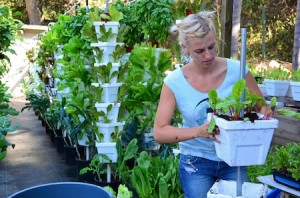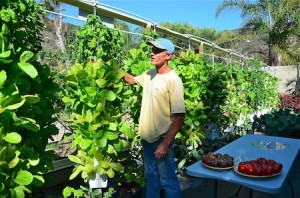MEDIA
Vertical Farm Harvests Its First Crop
By Rita Robinson | Laguna Beach Independent Newspaper, The "Indy" | September 9, 2012
Working from sun-up to sundown all summer, soaking his t-shirt to a steamy rag by 10 a.m. and happily baring his tanned and slightly bony chest until the cool-down of a setting sun, Erik Cutter has his sights set on green, the kind everyone can eat and the kind he says we can bank our children’s future on.

An Alegria Farms worker prepares hydroponic pots for seedlings
in Laguna Canyon. Photo by Danielle Robbins
It starts with an empty dirt lot off one of the trickiest curves on Laguna Canyon Road. Cutter stood facing an army of prickly weeds approaching the height of his slim 6-foot-4 frame, guarding the drought-parched stakehold against intruders. He saw his plans take hold and knew who would prevail.
Now, 14 weeks later, the same lot is inhabited by a burgeoning army of a constructive kind: 150 seven-foot hydroponic vertical towers strung like green feather-dusters popping out of a magician’s hat. Each tower is stuffed with endless rabbit ears of growing romaine, spinach, collard and kale leaves, 9,000 green plants in all. Impressive globes of beefsteak, Russian black krim and purple Cherokee heirloom tomatoes and trellises of dangling jewel-like cherry tomato clusters now crown a flood channel cleared of debris.
More than 50 local residents have signed up at Cutter’s Alegria Fresh “farmacy” for home delivery one, two or three times a week of a $20 bouquet filled with leafy greens and herbs.
Even though community supported agriculture farms, farmers markets and communal gardens are popping up in asphalt jungles around the country, Cutter vows to make the most from the least resources, including land, water and energy. With private investors he still hopes to attract, Cutter aims to make Alegria Farm the new purveyor of locally grown farm to table produce.
After seeding the project with $100,000 of his own money, Cutter plans on selling and installing the modules for a consultant’s fee, which he says will pay his team, including teenagers, who will deliver the greens and vegetables.
Cutter is an environmentalist unabashed about his roots as an entrepreneur. “I adhere to the three P’s: people, planet, profit, in that order,” he said. “You don’t lead with profit. If I treat something this way, profit comes in droves.”
With Alegria, he’s leading with another P: plants grown pesticide-free and nutrient-enriched on less land with fewer resources. Every day at Alegria, potable water is carefully mixed with a commercial nutrient formula and one gallon slowly drips into each tower of 60 plants nestled in water-retaining coconut husk fiber. Cutter claims the system requires 90 percent less water and yields 10 times more food than the typical farm.
Howard Resh, a Ph.D. in plant science and horticulture from the University of British Columbia and author of five books on hydroponics, said fortified water trumps soil every time. Overtaxed soil these days is often devoid of nutrients. The minerals consistently provided in a hydroponic solution, said Resh, who lectures and oversees hydroponic farms around the world, are the very same elements the plants would get from healthy soil but dirt is not necessary.
Alegría Farms’ founder Erik Cutter.
“Plants naturally evolved easily in soil because there was a large amount of it around at the time,” Resh said. Hydroponics, he said, provides the plant’s nutrients needs at more optimum levels than soil because the farmer can monitor what each plant is getting.
Cutter’s dream is to replicate space-saving vertical hydroponic farms where they will do the most good, namely the inner-city “food deserts” dotted with fast-food franchises and quick-marts.
A former soil-based organic farmer as well as the 15-year publisher of Baja Life magazine, Cutter calculates that it takes 1,000 square feet to feed one person on the average organic row farm. “Greens to greens, I can feed 100 people out of my 1,200 square feet,” he said. “I want to get rid of the brainwashing that’s gone on for the last 50 years that food comes from supermarkets and not from farms.”
His local-to-global plan is to build a small vertical farm every three to five miles, much like the distance between grocery stores, and have kids operating them. “This is an entrepreneurial venture now where kids can now actually own their own farm,” said Cutter. “It gets them off their I-Pads and Smart Phones and actually puts them right in the heart of growing food.”
And Cutter’s got people signing up to sustain his vision. Carlos Olamendi, who owns and operates Olamendi’s Express in Mission Viejo, recently agreed to exclusively serve Alegria salads, which include cilantro, tomatoes, chiles, sweet basil, epazote, peppermint, arugula and summer crisp, romaine and butter head lettuces, within hours of delivery.
Erik Strickland, who manages Alegria Farm, literally dropped his dress slacks and put on khaki shorts the first day he met Cutter, and hasn’t stopped working since. Growing up gardening in the Midwest, Strickland was looking for a job in horticulture after recently moving from Ohio where he was a salesman for Kellogg’s Keebler snacks division.
“I’ve always liked to keep my hands dirty,” said Strickland. “It was the way I was brought up. If kids start eating well, they’re going to do nothing but bring those good habits to the family.” Strickland brings his 4-year-old daughter to the farm on weekends. “It’s pretty simple. If you eat healthy and exercise, you’ve got a jump start.”
Cutter, who lives in Bluebird Canyon, has plans in hand to take his neighborhood farm concept and expand it to regional community centers, starting in Orange County. The master design, which he said is receiving intense interest, includes a revolving glass restaurant where patrons can watch produce being picked from the surrounding ½-acre hydroponic farm and prepared per order.
But Cutter said he’s not out to feed the world. “I’m just trying to find a better way to feed it,” he said, “that doesn’t damage our planet with soil-borne diseases. My favorite expression is ‘Just because you say it can’t be done only means you can’t do it.’”
http://www.lagunabeachindy.com/2012/09/09/vertical-farm-harvests-crop/
